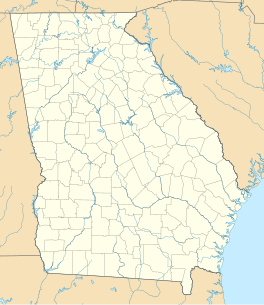
Glynn County is located in the southeastern part of the U.S. state of Georgia. As of the 2020 census, the population was 84,499. The county seat is Brunswick. Glynn County is part of the Brunswick, Georgia Metropolitan Statistical Area.

Brunswick is a city in and the county seat of Glynn County in the U.S. state of Georgia. As the primary urban and economic center of the lower southeast portion of Georgia, it is the second-largest urban area on the Georgia coastline after Savannah and contains the Brunswick Old Town Historic District. At the 2020 U.S. census, the population of the city proper was 15,210; the Brunswick metropolitan area's population as of 2020 was 113,495.

St. Simons Island is a barrier island and census-designated place (CDP) located on St. Simons Island in Glynn County, Georgia, United States. The names of the community and the island are interchangeable, known simply as "St. Simons Island" or "SSI", or locally as "The Island". St. Simons is part of the Brunswick metropolitan statistical area, and according to the 2020 U.S. census, the CDP had a population of 14,982. Located on the southeast Georgia coast, midway between Savannah and Jacksonville, St. Simons Island is both a seaside resort and residential community. It is the largest of Georgia's renowned Golden Isles. Visitors are drawn to the Island for its warm climate, beaches, variety of outdoor activities, shops and restaurants, historical sites, and natural environment.

Sidney Clopton Lanier was an American musician, poet and author. He served in the Confederate States Army as a private, worked on a blockade-running ship for which he was imprisoned, taught, worked at a hotel where he gave musical performances, was a church organist, and worked as a lawyer. As a poet he sometimes used dialects. Many of his poems are written in heightened, but often archaic, American English. He became a flautist and sold poems to publications. He eventually became a professor of literature at Johns Hopkins University in Baltimore, and is known for his adaptation of musical meter to poetry. Many schools, other structures and two lakes are named for him, and he became hailed in the South as the "poet of the Confederacy". A 1972 US postage stamp honored him as an "American poet".

Quercus virginiana, also known as the southern live oak, is an evergreen oak tree endemic to the Southeastern United States. Though many other species are loosely called live oak, the southern live oak is particularly iconic of the Old South. Many very large and old specimens of live oak can be found today in the Deep South region of the United States.

Paul Hamilton Hayne was a Southern American poet, critic, and editor.
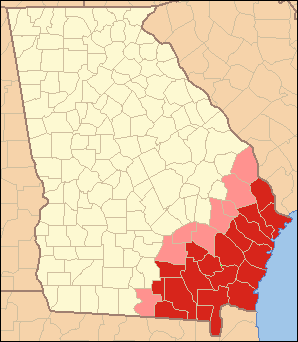
Southeast Georgia's Lower Coastal Plain is a subregion that encompasses the lowest-lying areas of the Atlantic coastal plain in the state, containing barrier islands, marshes, and swampy lowlands, as well as flat plains and low terraces. It differs from Georgia's Upper Coastal Plain in that it is lower in elevation with less relief and wetter soils. The United States Environmental Protection Agency defines the Lower Coastal Plain as an ecoregion, part of the larger, interstate Southern Coastal Plain.
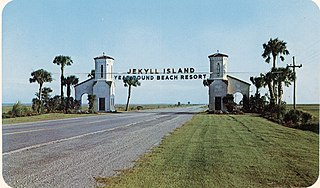
Jekyll Island is located off the coast of the U.S. state of Georgia, in Glynn County. It is one of the Sea Islands and one of the Golden Isles of Georgia barrier islands. The island is owned by the State of Georgia and run by a self-sustaining, self-governing body.

Gascoigne Bluff is a bluff next to the Frederica River on the western side of the island of St. Simons, Georgia which was a Native American campground, the site of a Franciscan monastery named San Buenaventura, and the site of the Province of Georgia's first naval base.
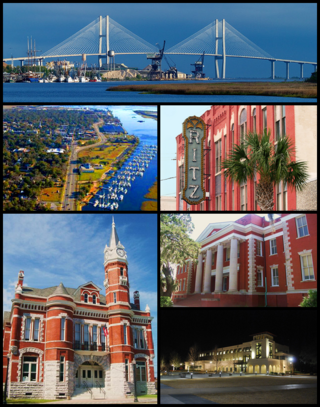
The Golden Isles of Georgia consist of barrier islands, and the mainland port cities of Brunswick and Darien, on the 100-mile-long coast of the U.S. state of Georgia on the Atlantic Ocean. They include St. Simons Island, Sea Island, Jekyll Island, Little St. Simons Island, Sapelo Island, Blackbeard Island, Historic Darien and Historic Brunswick. The islands are part of a long chain of barrier islands known as the "Sea Islands", located along the coasts of South Carolina, Georgia and northern Florida.

The Sidney Lanier Bridge is a cable-stayed bridge that spans the Brunswick River in Brunswick, Georgia, carrying four lanes of U.S. Route 17. The current bridge was built as a replacement to the original vertical-lift bridge, which was twice struck by ships. It is currently the longest-spanning bridge in Georgia and is 480 feet (150 m) tall. It was named for poet Sidney Lanier. Each year, there is the "Bridge Run" sponsored by Southeast Georgia Health System when the south side of the bridge is closed to traffic and people register to run the bridge.

Glynn Academy (GA) is an American public high school in Brunswick, Georgia, United States, enrolling 1,900 students in grades 9–12. Along with Brunswick High School, it is one of two high schools in the Glynn County School System. Glynn Academy offers technical, academic, and Advanced Placement programs and is accredited by the Georgia Department of Education and the Southern Association of Colleges and Schools. The school has consistently been ranked among the top public high schools in the United States by Newsweek.

"The Marshes of Glynn" is one of Sidney Lanier's poems featured in Hymns of the Marshes, an unfinished set of lyrical nature poems that describe the open salt marshes of Glynn County in coastal Georgia. While some believe the poem was written while Lanier was visiting the area in 1875, there is speculation that the majority was written in Baltimore during 1878 as part of an entry for the anthology A Masque of Poets, a collection of works from various artists. Although A Masque of Poets received poor reviews from readers, "The Marshes of Glynn" was considered by critics to be one of the better entries of the book.
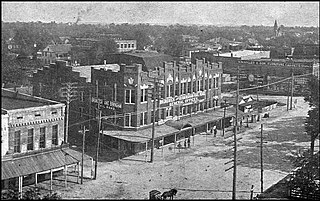
The recorded History of Brunswick, Georgia dates to 1738, when a 1,000-acre (4 km2) plantation was established along the Turtle River. By 1789, the city was recognized by President George Washington as having been one of five original ports of entry for the American colonies. In 1797, Brunswick's prominence was further recognized when it became the county seat of Glynn County, a status it retains to this day. During the later stages of the Civil War, with the approach of the Union Army, much of the city was abandoned and burned. Economic prosperity eventually returned, when a large lumber mill was constructed in the area. By the late 19th-century, despite yellow fever epidemics and occasional hurricanes, business in Brunswick was thriving, due to port business for cotton, lumber, naval stores, and oysters. During this period, Brunswick also enjoyed a tourist trade, stimulated by nearby Jekyll Island, which had become a posh, exclusive getaway for some of the era's most influential people. World War I stimulated ship building activity in Brunswick. But it was not until World War II that the economy boomed, when 16,000 workers were employed to produce ninety-nine Liberty ships and "Knot" ships. During the war, Brunswick's Glynco Naval Air Station was, for a time, the largest blimp base in the world. Since the end of World War II, the city has enjoyed a period of moderate economic activity, centered on its deep natural port, which is the westernmost harbor on the eastern seaboard. In recent years, in recognition of a thriving local enterprise, Brunswick has declared itself to be the "Shrimp Capital of the World".

F.J. Torras Causeway is a causeway located in Glynn County, Georgia, USA that connects the city of Brunswick, Georgia to St. Simons Island, Georgia.

Igbo Landing is a historic site at Dunbar Creek on St. Simons Island, Glynn County, Georgia. It was the setting of a mass suicide in 1803 by captive Igbo people who had taken control of their slave ship and refused to submit to slavery in the United States. The event's moral value as a story of resistance towards slavery has symbolic importance in African American folklore as the flying Africans legend, and in literary history.

The Sidney Lanier Cottage is a historic cottage on High Street in Macon, Georgia, that was the birthplace of poet, musician, and soldier Sidney Lanier. Sidney Lanier Cottage was purchased by the Middle Georgia Historical Society in 1973, and opened to the public in 1975. Until 2021, the Sidney Lanier Cottage served as a museum, event space, and home of the Lanier Center for Literary Arts. Though now a private residence, it is still occasionally used for events by the Historic Macon Foundation.

The Lover's Oak is a notably historic and large Southern live oak tree in Brunswick, Georgia. Located in the Brunswick Old Town Historic District, the tree is reportedly over 900 years old. The tree has a trunk diameter of 13 feet (4.0 m) and has 10 main limbs.

The Sidney Lanier Monument is a public monument in Atlanta, Georgia, United States. Located in Piedmont Park, the monument consists of a bust of Sidney Lanier, a notable poet from Georgia. The monument was dedicated in 1914.

